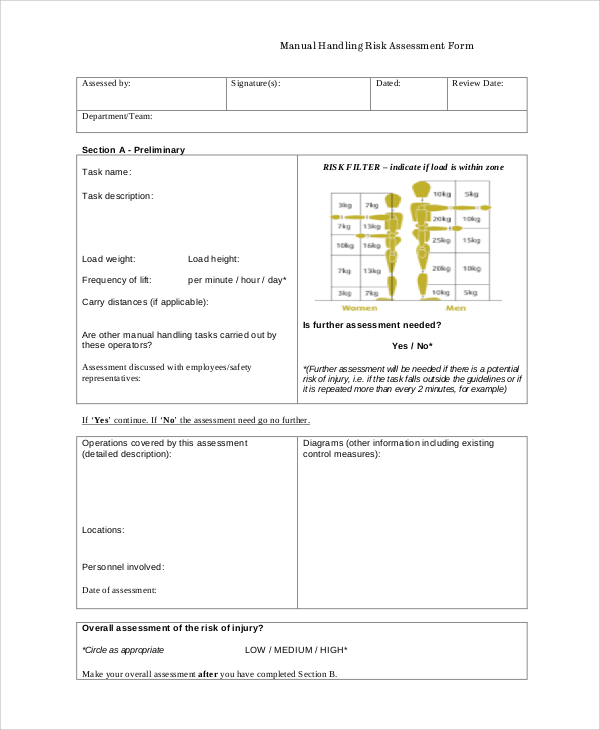Lifting Safety Manual Template
Posted : admin On 08.02.2020File Format. PDF Size: 175 KB Uses & Purpose of Sample Manual Risk Handling Assessment Heavy object handling – Material or Human is a daunting physical job and those people who are a day in and day out in such profile can face ligament tears and ailments.
Some cases can lead to serious injuries which can even. The dependants obviously are badly affected. Risk assessment of this activity is a must so that safety zones can be widened and proper care is taken of the operator without his / her future being hampered. You can also see When do I Need the Sample Manual Risk Handling Assessment Lackluster safety standards often lead to fatalities.
Sometimes even the best safety implementation standards followed can also lead to an injury due to error on the workers part. There is nothing called as total fool proof systems. This leads us to the second aspect namely post-accident compensation. You can also see The workers and their dependents have to be adequately compensated arising out of any long-term injury sustained while material handling. Most of the companies involved in such work are regulated under law to take insurance coverage so that necessary compensation accrues to the worker / dependants which take care of their living needs on a long term basis.
Safety Manual
Are There any Legal Provisions for Material Handling Risk Assessment? Industrial and labor acts of most countries have specific regulations against any form of risk involvement which can be potentially dangerous for those involved in the activity. Non-conformity can lead to penalization and legal action. In all such activities, due safety standards are mandatory to be followed, which nullifies any sort of body risk factor to the workers. You can also see What is the Role of Third Party Agencies in this Sector?
Health and Safety Environment (HSE) is a very crucial subject matter in almost all commercial offices and segments. Those organizations which carry out labor based activities follow several norms set by third party safety audit consultants. It is mandatory for safety standards to be implemented depending upon the domain. There are ISO standards like 14001 and 18001 which deal with safety hazards including a lifting of material manually. Organizations have to undertake a detailed study and appoint proper consultants to eliminate risks. You can also see All our templates are in PDF and word format and we try to cover the various aspect of Risk assessment in manual handling.


Construction Safety Manual Template
Since this comes under provisions of HSE, new acts and laws are passed with changing times. If you have any DMCA issues on this post, please!
Posted at 09:22h in, by Safe Lifting Techniques Back injuries account for about one in every five job-related injuries in workplaces. Disabling are no laughing matter for workers who lose time from work or from personal activities. The sad truth is that most of the pain and lost time can been prevented if you are aware of how the back functions and how to lift safely to protect your back. The back is a network of fragile ligaments, discs, and muscles which can easily be thrown out of order. The back’s complex design breaks down when it’s forced to perform activities it was not designed to do. Lifting with the back twisted or bent just begs for a pulled muscle or ruptured disc. One sure way to risk injuring the back is to lift heavy or bulky loads improperly or unassisted.
Manual Lifting Safety Program Template
Never be afraid to ask for help with loads that you know you cannot lift safely. Lift with good sense and a little extra help from a co-worker or mechanical aid when necessary. If you decide you are capable of lifting a light load, make sure you lift correctly.
Move in so that your feet are close to the base of the object to be lifted. Face the object squarely. Bend your knees and squat over the item to be lifted.
In this position, the back gets added lifting strength and power from the legs and arms. Move up close to the item, because the backbone must act as a supporting column, and it takes the least strain close in. Tilt the item on edge with its long axis straight up so that the center of the weight is as high as possible above the ground. Still squatting, the feet should be set with legs pointed right at the load, with the back straightened, the worker may then grasp the load with both arms and slowly stand up with it, pushing up with the leg muscles. If you can’t lift slowly, you can’t lift safely. A good way to learn the right from the wrong way to lift is to practice lifting correctly a few times. You will notice that the correct way to lift is the easiest way to lift the load, with the least strain and awkwardness.
To lift the wrong way will, over time, cause injury and pain. The back can be damaged quickly but can take a long time to heal.